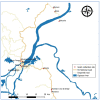Pilot Malacology Surveys for the Intermediate Hosts of Schistosomiasis in Rural and Semi-Urban Areas of the Moyen-Ogooué Province, Gabon
- PMID: 35051117
- PMCID: PMC8779524
- DOI: 10.3390/tropicalmed7010001
Pilot Malacology Surveys for the Intermediate Hosts of Schistosomiasis in Rural and Semi-Urban Areas of the Moyen-Ogooué Province, Gabon
Abstract
The objective of this pilot malacological survey was to identify the snail intermediate hosts for Schistosoma haematobium in endemic rural and semi-urban areas of Gabon. Snails were collected, morphologically identified, and tested for infection by cercarial shedding. Released cercariae were morphologically identified using low-power light microscopy. A total of six species of snails were collected throughout the study area, with Bulinus truncatus, B. forskalii, and Potadoma spp. being the most predominant species collected. Only the Bulinus species were tested for infection by cercarial shedding, of which only B. truncatus shed cercariae. Some B. truncatus shed mammalian schistosome cercariae, while others shed Gymnocephalus cercariae. Our results indicate that B. truncatus appears to be a potential intermediate host of schistosomiasis in Gabon, where cases of S. haematobium, S. guineensis, and S. intercalatum infection are reported. However, it will be important to further understand the species diversity and transmission dynamics of schistosomes.
Keywords: Bulinus spp.; Gabon; Schistosoma haematobium; cercarial shedding; schistosomiasis.
Conflict of interest statement
The authors declare no conflict of interest.
Figures
Similar articles
-
Interactions between Schistosoma haematobium group species and their Bulinus spp. intermediate hosts along the Niger River Valley.Parasit Vectors. 2020 May 24;13(1):268. doi: 10.1186/s13071-020-04136-9. Parasit Vectors. 2020. PMID: 32448268 Free PMC article.
-
Molecular characterization and distribution of Schistosoma cercariae collected from naturally infected bulinid snails in northern and central Côte d'Ivoire.Parasit Vectors. 2019 Mar 19;12(1):117. doi: 10.1186/s13071-019-3381-3. Parasit Vectors. 2019. PMID: 30890180 Free PMC article.
-
The spatial and seasonal distribution of Bulinus truncatus, Bulinus forskalii and Biomphalaria pfeifferi, the intermediate host snails of schistosomiasis, in N'Djamena, Chad.Geospat Health. 2014 Nov;9(1):109-18. doi: 10.4081/gh.2014.9. Geospat Health. 2014. PMID: 25545929
-
Interactions between intermediate snail hosts of the genus Bulinus and schistosomes of the Schistosoma haematobium group.Parasitology. 2001;123 Suppl:S245-60. doi: 10.1017/s0031182001008046. Parasitology. 2001. PMID: 11769287 Review.
-
[Schistosomiasis due to Schistosoma intercalatum and urbanization in central Africa].Bull Soc Pathol Exot. 2003 Aug;96(3):183-6. Bull Soc Pathol Exot. 2003. PMID: 14582292 Review. French.
Cited by
-
Imported Schistosomiasis in Southwestern Europe: Wide Variation of Pure and Hybrid Genotypes Infecting Sub-Saharan Migrants.Transbound Emerg Dis. 2025 Apr 18;2025:6614509. doi: 10.1155/tbed/6614509. eCollection 2025. Transbound Emerg Dis. 2025. PMID: 40718473 Free PMC article.
-
Liver fluke and schistosome cross-infection risk between livestock and wild mammals in Western Uganda, a One Health approach.Int J Parasitol Parasites Wildl. 2024 Nov 19;25:101022. doi: 10.1016/j.ijppaw.2024.101022. eCollection 2024 Dec. Int J Parasitol Parasites Wildl. 2024. PMID: 39687763 Free PMC article.
References
-
- WHO Water-Related Diseases. [(accessed on 25 May 2021)]. Available online: http://www.who.int/water_sanitation_health/diseases-risks/diseases/schis...
-
- World Health Organization Fact Sheet: Schistosomiasis. [(accessed on 10 June 2021)]. Available online: http://www.who.int/news-room/fact-sheets/detail/schistosomiasis.
-
- World Health Organization . Vector. [(accessed on 15 July 2021)]. Freshwater Snails; pp. 337–356. Available online: https://www.who.int/water_sanitation_health/resources/vector337to356.pdf.
-
- Adriko M., Tinkitina B., Tukahebw E.M., Standley C.J., Stothard J.R., Kabatereine N.B. The epidemiology of schistosomiasis in Lango region Uganda 60 years after Schwetz 1951: Can schistosomiasis be eliminated through mass drug administration without other supportive control measures? Acta Trop. 2018;185:412–418. doi: 10.1016/j.actatropica.2018.06.009. - DOI - PubMed
LinkOut - more resources
Full Text Sources
Research Materials
Miscellaneous



